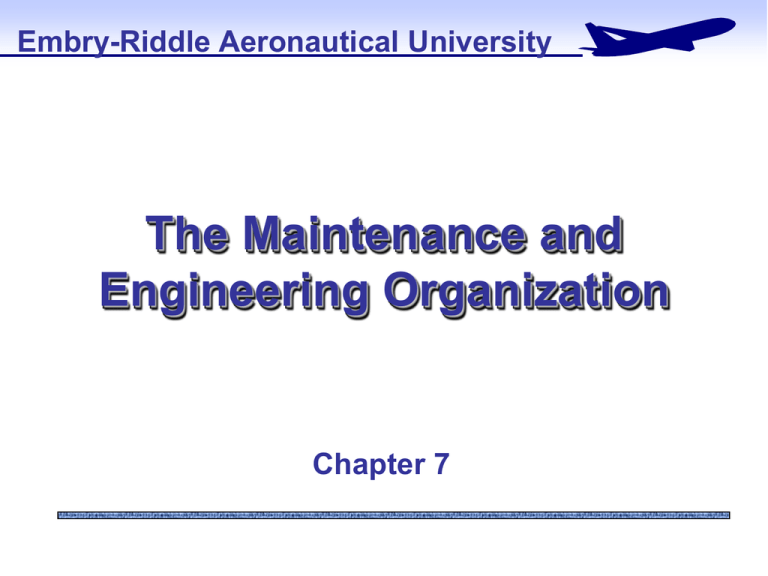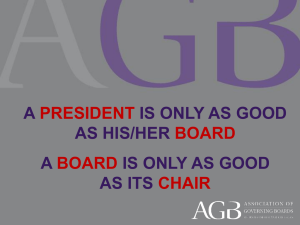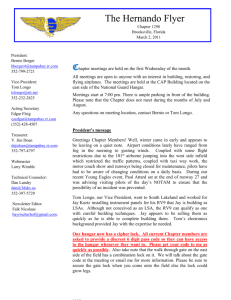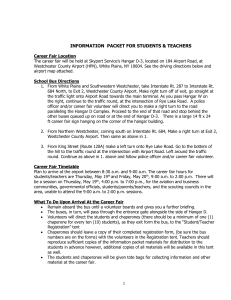The Maintenance and Engineering Organizational Chart
advertisement

Embry-Riddle Aeronautical University The Maintenance and Engineering Organization Chapter 7 The Maintenance and Engineering Organization Introduction Organizational Structure Span of Control, Grouping of Similar Functions, Separation of Production and Oversight Functions The Maintenance and Engineering Organizational Chart Organization Structure and the TPPM (Technical Policies and Procedures Manual) Variations from the Typical Organization Summary Introduction Key point: The organizational structure must allow the company to meet its goals and objectives and each unit within the company must be endowed with sufficient personnel and authority to carry out those objectives and meet those goals Organizational Structure Three main concepts: Span of Control Grouping of Similar Functions Separation of Maintenance Activities from Oversight Span of Control Amount of personnel or activities one can effectively supervise of control By limiting the number of people that a manager has to supervise, the work is divided and the organization is run more efficiently Levels of Management determine # of personnel Higher usually lower personnel Lower line maintenance - more Grouping of Similar Functions Grouping under One director, manager, or supervisor for like tasks: Refer to Fig. 7-1 pg. 86 Separation of Production & Oversight Functions FAA rules require oversight/selfmonitoring functions of own rules and those of a regulatory authority QA, QC, reliability and safety programs Must be separate to avoid conflict of interest Maintenance & Engineering Organizational Chart The M&E department is responsible for conducting all scheduled/unscheduled maintenance, modifications within the limits of the maintenance schedule and still meet the flight schedule. OPS is responsible for the flight planning, to include flight crews, crew training etc. Both the VP of M&E and OPS will have equal weight…one can NOT exist without the other Maintenance Organization Five Major Functions: Technical Services Engineering, planning, training, technical publications, and computing Aircraft Maintenance Flight line, hangar, outstations, and maintenance control Overhaul Shops Off-aircraft maintenance, repair, and overhaul Materiel Services Ordering and maintaining supplies, handling warranties, and moving repairable and consumable parts through the system Maintenance Program Evaluation Monitoring activity for the organization, its workers and its suppliers Technical Services Engineering Development of the initial maintenance program Tasks, intervals, schedules, etc. Evaluation of service bulletins/letters for possible inclusion into the airline's equipment or practices Oversight of those SB/SL deemed beneficial Oversight of airworthiness directives required by regulatory authorities Evaluation of problems identified by the reliability program and any problems from maintenance checks Establish the policies and procedures for the M&E organization Involved in planning of facilities to ensure it meets M&E requirements Technical Services Production Planning and Control Responsible for maintenance scheduling and planning Manpower, parts, facilities, tools and special assistance for maintenance or modifications Functions include: Short, medium and long term M&E planning Establish standards for manhours, materiel, facilities, tools and equipment Work scheduling Control of hangars On-aircraft maintenance Monitor progress of in-work maintenance Technical Services Training Technical Publications Curriculum, course development, administration, and training records for all personnel Able to establish new and special training based on needs of the aircraft New equipment, modifications, test procedures etc.. Maintains Master Library with list of all documents, too include number of copies and format – paper, microfilm, or electronic media Responsible of tracking and issuing all revisions to respective work centers Must do periodic checks to ensure condition and current Computing Services Selection of software & hardware – with usage information and requirement input from the individual Training of M&E personnel on usage Continuing support Aircraft Maintenance Three functions: Flight Line Maintenance Turnaround maintenance and servicing, daily checks, short interval checks and minor modifications Hangar Maintenance Flight line maintenance, hangar maintenance and Maintenance Control Center Repairs, modifications, engine changes, painting, corrosion control Support shops – welding, seat and interior fabric, composites and GSE Maintenance Control Center Tracks all flights in and out, and maintenance needs Overhaul Shops Engine Shop Avionics Shop Radios, navigation, radar, communication, electrical Mechanical Component Shop Repair on types of engines and APUs Actuators, hydraulic systems, flight control surfaces, fuel systems, oxygen, pneumatics, etc. Structures Sheet metal and other structural elements Materiel (Supply) Responsible for: Purchasing Stocking and distribution Inventory control Shipping and receiving To include M&E and administration and management Maintenance Program Evaluation Quality Assurance Ensures adherence to company policies and procedures as well as FAA requirements and those of suppliers Conducts periodic audits to ensure compliance Quality Control Routine inspections of maintenance and repair work Certify maintenance and inspection personnel Manage the (Required Inspection Items) RIIs program Calibration of tools and equipment Oversees the NDT/NDI /program procedures Maintenance Program Evaluation Reliability Ensures that any problem areas are addressed Data collection and analysis and publication of monthly reliability report Safety Develops, implements and administers the safety and health related activities for M&E Handles all reports and claims Summary of Management Levels Responsible for all outlined Administrative and personnel duties Budgeting and planning (long and short term) Necessary interaction Meetings, letters, seminars, conferences etc… Management has determined structure based on requirements to meet goals and objectives of organization Small Airlines All activities are addressed regardless of size although some may be combined i.e. quality control functions to qualified maintenance personnel Technical publications, training, and production planning and control may be under engineering Line and hangar maintenance may be separate departments but utilize same personnel based on quals, certifications and skills May not have own hangar maintenance – may have to subcontract Summary Introduction Organizational Structure Span of Control, Grouping of Similar Functions, Separation of Production and Oversight Functions The Maintenance and Engineering Organizational Chart Organization Structure and the TPPM (Technical Policies and Procedures Manual) Variations from the Typical Organization Questions?








